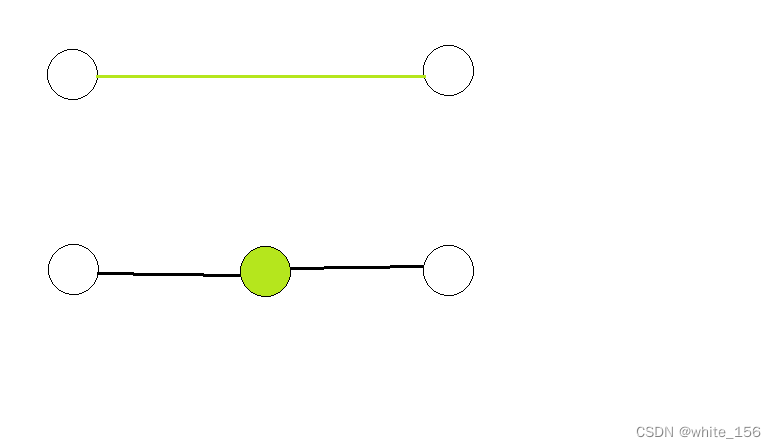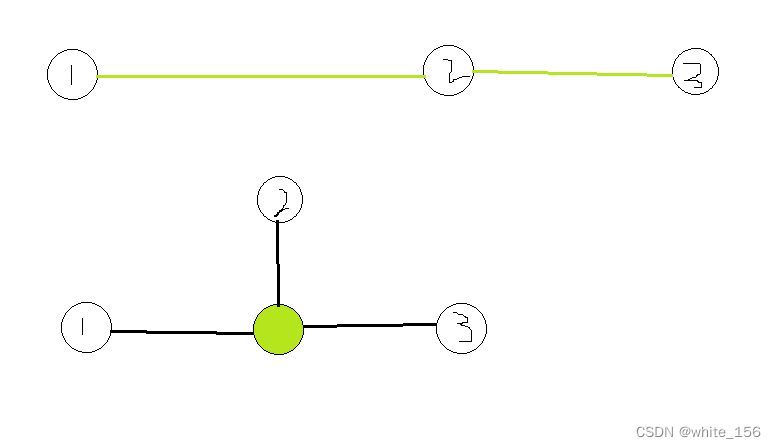题意不讲了,不如去题干看图。
传统dp,每个点有两个选择,那么建桥要么不建。需要注意的是在状态转移的时候,桥是有长度的,如果不建需要前d格中建桥花费最少的位置作为状态转移的初态。
#include <iostream>
#include <string.h>
#include <algorithm>
#include <math.h>
#include <time.h>
#include <set>
#include <unordered_set>
#include <map>
#include <queue>
#define IOS ios::sync_with_stdio(0);cin.tie(0);
#define mem(A,B) memset(A,B,sizeof(A));
#define rep(index,start,end) for(int index = start;index < end; index ++)
#define drep(index,start,end) for(int index = start;index >= end; index --)
using namespace std;
typedef long long ll;
const int maxn = 2e5+5;
struct contianer {
private:
int step;
int pos = 0;
ll loop[maxn];
multiset<ll> store;
public:
contianer(int step):step(step) {}
void add(ll x) {
int now = pos % step;
// need to remove
if (pos >= step) {
store.erase(store.find(loop[now]));
}
loop[now] = x;
store.insert(x);
pos ++;
}
/**
* get min number
*/
ll get() {
return *store.begin();
}
void setStep(int s);
void clear();
};
void contianer::setStep(int s) {
step = s;
}
void contianer::clear() {
store.clear();
pos = 0;
}
ll sum[128];
int store[maxn];
ll dp[maxn][2];
int main() {
IOS
int t;
cin>>t;
while(t--) {
int n,m,k,d;
cin>>n>>m>>k>>d;
contianer heap(d);
sum[0] = 0LL;
// input and dp
rep(_,0,n) {
// input
rep(i,0,m) cin>>store[i];
// init
heap.clear();
heap.add(store[0] + 1);
dp[0][0] = dp[0][1] = store[0] + 1;
// dp
rep(i,1,m-1) {
ll min_cost = heap.get();
dp[i][0] = min_cost;
dp[i][1] = min(dp[i-1][0], min_cost) + store[i] + 1;
// cout<<"dp["<<i<<"][0]:"<<dp[i][0]<<" dp["<<i<<"][1]:"<<dp[i][1]<<endl;
heap.add(dp[i][1]);
}
// cost
sum[_ + 1] = min(dp[m-2][1], dp[m-2][0]) + 1LL;
// cout<<sum[_+1]<<endl;
}
// pre sum
rep(i,1,n+1) sum[i] += sum[i-1];
// the k min
ll ans = sum[k] - sum[0];
rep(i,k+1,n+1) {
ans = min(ans, sum[i] - sum[i-k]);
}
// cout
cout<<ans<<endl;
}
return 0;
}
求两数和的plus版本。给出数组a,现在要分别从d和f挑选一个数相加后放入a,使得所有 a i + 1 − a i a_{i+1} - a_i ai+1−ai中最大值尽可能小。
显然,我们只要找到在没有挑选插入前 a i + 1 − a i a_{i+1} - a_i ai+1−ai的最大值以及 i i i的值,然后构造 a i + 1 > d + f > a i a_{i+1} > d+f > a_i ai+1>d+f>ai,就可以破坏最大值。且 d + f = a i + 1 + a i 2 d+f = \frac {a_{i+1} + a_i}{2} d+f=2ai+1+ai时,能将最大值分割的尽可能小。
其中,如果最大值和第二大值一样,那么无论怎么分割都改变不了最大值,可以直接输出。
至于怎么让 d + f d+f d+f尽可能靠近中点就不细说了,固定d然后二分搜索f。这里我脑干缺失写了个int target = abs(aim - commonA);我是真的睿智
#include <iostream>
#include <string.h>
#include <algorithm>
#include <math.h>
#include <time.h>
#include <set>
#include <map>
#include <queue>
#define IOS ios::sync_with_stdio(0);cin.tie(0);
#define mem(A,B) memset(A,B,sizeof(A));
#define rep(index,start,end) for(int index = start;index < end; index ++)
#define drep(index,start,end) for(int index = start;index >= end; index --)
using namespace std;
typedef long long ll;
const int maxn = 2e5+5;
struct record{
int val;
int ind;
};
int store[maxn/2];
record dif[maxn/2];
int d[maxn], f[maxn];
bool cmp(const record& a, const record& b) {
return a.val < b.val;
}
int abs(int a) {
if (a<0) return -a;
else return a;
}
int main() {
IOS
int t;
cin>>t;
while(t--) {
int n,m,k;
cin>>n>>m>>k;
int pos = 0;
cin>>store[0];
rep(i,1,n) {
cin>>store[i];
dif[pos].ind = i;
dif[pos ++].val = store[i] - store[i-1];
}
sort(dif, dif+pos,cmp);
// rep(i,0,pos) cout<<dif[i].val<<endl;
int len_d , len_f;
if (m < k) {
rep(i,0,m) cin>>d[i];
sort(d, d+m);
len_d = m;
rep(i,0,k) cin>>f[i];
sort(f, f+k);
len_f = k;
} else {
rep(i,0,m) cin>>f[i];
sort(f,f+m);
len_f = m;
rep(i,0,k) cin>>d[i];
sort(d,d+k);
len_d = k;
}
if (pos > 2 && dif[pos-1].val == dif[pos-2].val) {
cout<<dif[pos-1].val<<endl;
continue;
}
int sup = store[dif[pos-1].ind];
int inf = store[dif[pos-1].ind - 1];
int aim = inf + (sup - inf)/2;
int minn = dif[pos-1].val;
rep(i,0,len_d) {
int commonA = d[i];
if (commonA >= sup) break;
int target = aim - commonA;
// cout<<"d[i]:"<<d[i]<<" target:"<<target<<endl;
auto it = upper_bound(f, f+len_f-1, target);
// cout<<"it:"<<it<<endl;
int commonB = *it;
// cout<<"find:"<<commonB<<endl;
int num = commonA + commonB;
if (inf<num && num<sup)
minn = min(minn, max(sup - num ,num - inf));
if (it != f) {
commonB = *(it-1);
num = commonA + commonB;
if (inf<num && num<sup)
minn = min(minn, max(sup - num ,num - inf));
}
}
/*
if (d[0] + f[0] < store[0]) {
aim = store[0];
rep(i,0,len_d) {
int commonA = d[i];
if (commonA >= aim) break;
int target = abs(aim - commonA);
auto it = lower_bound(f, f+len_f-1, target-1);
int commonB = *it;
cout<<"commonA:"<<commonA<<" commonB:"<<commonB<<" target:"<<target<<endl;
int num = commonA + commonB;
if (num < store[0])
minn = min(minn, store[0] - num);
if (it != f) {
commonB = *(it-1);
num = commonA + commonB;
if (num < store[0])
minn = min(minn, store[0] - num);
}
}
}
aim = store[n-1];
if (d[len_d-1] + f[len_f-1] > aim)
rep(i,0,len_d) {
int commonA = d[i];
int target = abs(aim - commonA);
auto it = upper_bound(f, f+len_f-1, target+1);
int commonB = *it;
int num = commonA + commonB;
if (num > aim) {
minn = min(minn, num - aim);
}
if(it == f) break;
}
*/
cout<<max(minn, pos>=2? dif[pos-2].val : 0)<<endl;
}
return 0;
}
很好的图论使我小脑萎缩
边染色,求A->B最少经过几种颜色。其中相同颜色的边一定构成连通图。
机智如我并没有按照题解中加边的思路,而是采用合并点的方式,从颜色的维度处理。将相同颜色的边视为从同一个点出发(因为相同颜色内移动不会影响结果,只有移动到新的颜色上才会影响结果),从而将问题转化为最短路。采用bfs那么首先经过的颜色一定是最短路,从而可以作为优化的条件。
此外由于是边染色,所有可能一个点会被多个颜色所合并。如果在颜色A的合并点里走到了点v,同时v又连接B、C等颜色的边,虽然后续B、C颜色的合并也会重新遍历v的边,但是由于bfs的特性此时的遍历不会影响已经过的颜色A,也不会加入新的颜色(因为v涉及的所有颜色都在颜色A的合并点中加入到了队列),所以图中的每个点只需要访问一次,不需要重复访问。
没有这个优化会T 嘤嘤嘤
#include <iostream>
#include <string.h>
#include <algorithm>
#include <math.h>
#include <time.h>
#include <set>
#include <map>
#include <queue>
#define IOS ios::sync_with_stdio(0);cin.tie(0);
#define mem(A,B) memset(A,B,sizeof(A));
#define rep(index,start,end) for(int index = start;index < end; index ++)
#define drep(index,start,end) for(int index = start;index >= end; index --)
using namespace std;
typedef long long ll;
const int maxn = 2e5+5;
struct node{
int to;
int color;
};
queue<int> Q;
bool vis[maxn],visNode[maxn];
int dis[maxn];
set<int> colors;
set<int> colorSet[maxn];
vector<node> adj[maxn];
int main() {
IOS
cout.tie(0);
int t;
cin>>t;
while(t--) {
for(auto it=colors.begin();it!=colors.end();it++){
vis[*it] = false;
colorSet[*it].clear();
}
colors.clear();
int n,m;
cin>>n>>m;
rep(i,0,n+1) {
adj[i].clear();
visNode[i] = false;
}
rep(i,0,m) {
int commonA,commonB,color;
cin>>commonA>>commonB>>color;
adj[commonA].push_back({commonB, color});
adj[commonB].push_back({commonA, color});
colorSet[color].insert(commonA);
colorSet[color].insert(commonB);
colors.insert(color);
}
int commonA,commonB;
cin>>commonA>>commonB;
if (commonA==commonB) {
cout<<0<<endl;
continue;
}
for(auto it=colors.begin();it!=colors.end();it++)
dis[*it] = INT_MAX;
visNode[commonA] = true;
rep(i,0,adj[commonA].size()) {
node edge = adj[commonA][i];
if (!vis[edge.color]) {
Q.push(edge.color);
// cout<<"push color:"<<edge.color<<endl;
dis[edge.color] = 1;
vis[edge.color] = true;
}
}
while(!Q.empty()) {
int now = Q.front();
// cout<<"color:"<<now<<" dis:"<<dis[now]<<endl;
Q.pop();
for(int v : colorSet[now]) {
if (visNode[v]) continue;
visNode[v] = true;
int len = adj[v].size();
rep(i,0,len) {
node next = adj[v][i];
int next_color = next.color;
if (vis[next_color] || visNode[next.to]) continue;
dis[next_color] = dis[now]+1;
Q.push(next_color);
vis[next_color] = true;
}
}
}
int ans = INT_MAX;
rep(i,0,adj[commonB].size()) {
node edge =adj[commonB][i];
int des_color = edge.color;
ans = min(ans, dis[des_color]);
}
cout<<ans<<endl;
}
return 0;
}
官方题解则是通过加边的方法传送门
 将染色边转化为一个新的染色节点连接到原有边的端点。可能这样画体现不出这个方法精妙之处。
将染色边转化为一个新的染色节点连接到原有边的端点。可能这样画体现不出这个方法精妙之处。 点多了就能看出来,这样形成一个星形的连接,相同颜色的点之间移动都只需要经过两条边。仍然还是bfs,只不过由于边多加了,所以需要最终结果/2
点多了就能看出来,这样形成一个星形的连接,相同颜色的点之间移动都只需要经过两条边。仍然还是bfs,只不过由于边多加了,所以需要最终结果/2





